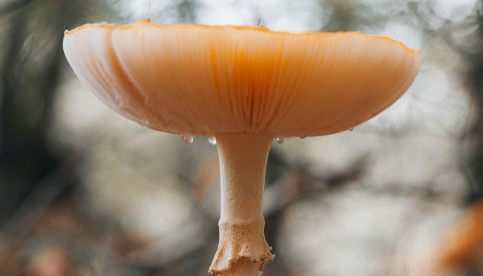![5 Dangerous Reishi Look Alikes You Need to Avoid [Expert Tips]](http://hemplucid.com/cdn/shop/articles/anya-chernik-1Y2r7kgoRXg-unsplash_1_520x500_9714e15e-d12f-4345-b4f8-852138f59591.png?crop=center&height=276&v=1734630741&width=483)
5 Dangerous Reishi Look Alikes You Need to Avoid [Expert Tips]
Reishi mushrooms are prized for their health benefits. But not all mushrooms that look like reishi are safe. Identifying reishi look-alikes is crucial.
You might wonder how to tell them apart. It's easier than you think. With a few key tips, you'll avoid potential risks.
In this article, you'll learn to spot the differences. Stay safe and enjoy the true benefits of reishi.
Key Takeaways
- Reishi Mushroom Identification: Genuine reishi mushrooms (Ganoderma lucidum) have shiny, varnished, red, dark brown, or black caps and produce a white spore print.
- Common Look-Alikes: Reishi look-alikes include Ganoderma applanatum, Ganoderma curtisii, and other Ganoderma species, which often have different colors, shapes, and spore prints.
- Risks of Misidentification: Consuming misidentified mushrooms can cause severe health issues such as nausea, vomiting, or life-threatening conditions, highlighting the importance of correct identification.
- Identification Tips: Pay attention to color, cap shape, spore prints, and habitat; consulting field guides and experts can further ensure accurate identification.
Understanding Reishi Mushrooms
Reishi mushrooms, or Ganoderma lucidum, have a shiny, varnished appearance and a woody texture. They can grow up to 10 inches in diameter and usually have a fan-shaped or kidney-shaped cap.
They display vivid colors such as red, dark brown, and black. These colors stem from bioactive compounds like triterpenes and polysaccharides, known for their health benefits.
To differentiate reishi from its lookalikes, observe the white spore print they produce. This feature helps in distinguishing them from other fungi.
Key tips:
- Appearance: Shiny, varnished look.
- Size: Up to 10 inches.
- Color: Red, dark brown, or black.
- Spore Print: White.
Being aware of these characteristics ensures you can identify authentic reishi mushrooms safely. Use this guide as your quick reference to ensure you're consuming the right fungi.
Common Reishi Look Alikes
Reishi mushrooms often get confused with other species due to their similar appearance. Below are common reishi look-alikes and key differences to help you identify them correctly.
Ganoderma Applanatum
Ganoderma applanatum, or Artist's Conk, is a bracket fungus known for its large, flat, woody fruiting body. Unlike reishi's red hues, this species has a tan to brown underside. Its large, flat cap features a glossy surface, often adorned with unique patterns that resemble brushstrokes.
Key Identification Points:
- Tan to brown underside
- Large, flat cap
- Glossy surface with artistic patterns
Ganoderma Curtisii
Ganoderma curtisii, known as Curtis' Ganoderma, displays a shelf-like growth habit. Its cap, which can be reddish-brown or white, has a smooth or slightly cracked surface. Compared to reishi, this species lacks the vivid coloration and shiny appearance.
Key Identification Points:
- Reddish-brown or white cap
- Shelf-like growth habit
- Smooth or slightly cracked surface
Ganoderma Lucidum
Ganoderma lucidum, commonly recognized as reishi, is notable for its shiny, red-hued cap and a white spore print. These characteristics set it apart from other Ganoderma species. Reishi's vivid colors and large size further distinguish it from other look-alikes.
- Shiny, red-hued cap
- White spore print
- Large size and vivid colors
Identifying Characteristics
Recognizing reishi mushrooms and their look-alikes can be tricky. Focus on these characteristics to differentiate them effectively.
Color and Shape
Reishi mushrooms have shiny, red-hued caps. Look for a kidney-shaped or asymmetrical semicircle in Ganoderma Sessile. Oregon Reishi shows reddish-brown to dark-brown caps with a varnished, shiny surface. Red-Belted Conk shares a reddish-brown to dark-brown cap but appears more bracket-like.
Spore Print
The spore print of reishi is white. This detail stands out when comparing Ganoderma Sessile vs reishi. Unfortunately, spore print details for other types like Ganoderma Oregonense and Red-Belted Conk aren't commonly specified. If spore print information is accessible, utilize it to confirm identification.
Habitat
You'll find reishi on hardwoods, usually deciduous trees. Ganoderma Sessile also thrives on hardwood trees across the eastern United States. Although the exact habitat for Ganoderma Oregonense is vague, it's usually found in similar environments. Red-Belted Conk, also known as Red-Belted Polypore, often grows on conifers. Pay attention to tree type to aid accurate identification.
Potential Risks of Misidentification
Identifying reishi mushrooms incorrectly can lead to consuming toxic species with serious health consequences. Ganoderma tsugae, Ganoderma oregonense, and Ganoderma curtisii all share similar shiny, lacquered appearances with reishi.
Severe Health Issues
Consumption of toxic look-alikes can cause nausea, vomiting, or even life-threatening conditions. According to studies, approximately 50% of mushroom poisonings involve misidentified species.
Misleading Appearances
The resemblance between Ganoderma sessile vs reishi and red belted conk vs reishi adds to the confusion. These mushrooms share physical traits, but only an expert eye can distinguish reishi's unique morphological features.
Geographical Confusion
If found on different trees or woods, mistaking Reishi for look-alikes like Red-Belted Polypore becomes easier. Knowledge of the mushroom's proper habitat helps in accurate identification.
Identifying Indicators
Focus on accurate identification by examining the glossy, kidney-shaped cap of reishi. Always double-check physical characteristics and consult multiple sources before consumption.
Consider these risks seriously to avoid potential misidentifications and health issues.
Tips for Proper Identification
Correctly identifying Reishi mushrooms is crucial to avoid consuming toxic look-alikes. Use these tips to ensure safety.
Consulting Experts
Reach out to mushroom identification experts to confirm your finds. Mycologists specialize in distinguishing Reishi from look-alikes like Ganoderma sessile. They can provide precise identification and ensure you avoid health risks. Expert advice is invaluable when you're unsure about a mushroom's characteristics.
Utilizing Field Guides
Field guides offer detailed descriptions and images to help identify Reishi mushrooms accurately. Look for guides featuring side-by-side comparisons of Reishi and look-alikes, such as the red belted conk and red belted polypore. These resources indicate key differences in color, size, and shape, making them indispensable for foraging.
Conclusion
Accurately identifying reishi mushrooms is crucial for your health and safety. Misidentifying them with toxic look-alikes like Ganoderma tsugae or Ganoderma curtisii can lead to serious health risks. Leveraging expert knowledge and reliable field guides can help you confidently distinguish genuine reishi from harmful substitutes. Always consult with mushroom experts and use detailed resources to ensure safe foraging. By taking these precautions, you can enjoy the true benefits of reishi mushrooms without compromising your well-being.
![5 Dangerous Reishi Look Alikes You Need to Avoid [Expert Tips]](http://hemplucid.com/cdn/shop/articles/anya-chernik-1Y2r7kgoRXg-unsplash_1_520x500_9714e15e-d12f-4345-b4f8-852138f59591.png?crop=center&height=276&v=1734630741&width=483)
Suggested Products from This Article

 NEW LOOK - BETTER SLEEP
NEW LOOK - BETTER SLEEP
Sleep Mushroom CBN Gummies - Blueberry Lemon

 NEW LOOK - STRESS RELIEF
NEW LOOK - STRESS RELIEF






![Best Time to Take Reishi: 3 Proven Tips for Optimal Benefits [Expert Insights]](http://hemplucid.com/cdn/shop/articles/madison-lavern-4gcqRf3-f2I-unsplash_1_1_520x500_af9f7d42-2db1-45d7-a09a-094115102cc4.png?crop=center&height=358&v=1734630663&width=568)
